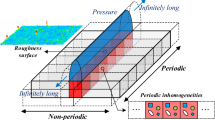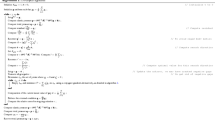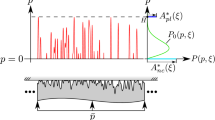Abstract
The contact of nominally flat surfaces can be treated as a bilateral periodic contact problem considering the stochastic surface similarity to the asperity distribution in a representative region. This similarity treatment method can be extended to material inhomogeneities. A novel numerical model for simulating the elastoplastic contact between nominally flat surfaces of materials containing inhomogeneities or coatings is developed via extending the concept of the discrete convolution and FFT (DC–FFT) algorithm with double superpositions of influence coefficients, which is named the DCSS–FFT algorithm. Several cases are analyzed with this new algorithm to examine its convenience, efficiency, and accuracy in dealing with complicated nominally flat–flat contact problems. The effects of surface roughness and material inhomogeneity are explored, and the mechanisms of contact surface failure are discussed.



















Similar content being viewed by others
Abbreviations
- \(a\) :
-
Half-width of the target domain, mm
- \(a_{0}\) :
-
Half-contact width, mm
- \(a_{1} , a_{2} , a_{3}\) :
-
Element size along the x, y, z directions, respectively, mm
- \(a_{x} ,a_{y} ,a_{z}\) :
-
Size of brick inhomogeneities along the x, y, z directions, respectively, mm
- \(C_{ijkl} ,C_{ijkl}^{*}\) :
-
Coefficients of elastic properties for matrix and inhomogeneities, respectively
- \(D\) :
-
Influence coefficients relating contact pressure and surface displacement
- \(D_{ijk}^{*}\) :
-
Influence coefficients relating eigenstrain and surface displacement
- \(D_{ij}^{E}\) :
-
Influence coefficients relating contact pressure and subsurface elastic stress
- \(D^{sum}\) :
-
Summation of ICs
- \(K_{ijk}^{P}\) :
-
Influence coefficients relating plastic strain and surface residual displacement
- \(E,E^{*}\) :
-
Young’s modulus of matrix and inhomogeneities, respectively, MPa
- \(G\) :
-
Green function relating contact pressure and surface displacement
- \(h\) :
-
Total gap between contact surfaces, mm
- \(h_{0}\) :
-
Initial gap (no deformation) between contact surfaces, mm
- \(l_{x} , l_{y} , l_{z}\) :
-
Size of target domain along x, y, z directions, respectively, mm
- \(2m + 1\) :
-
Number of copies chosen to do the ICs superposition
- \(Nx, Ny, Nz\) :
-
Total element number along the x, y, and z directions, respectively
- \(p\) :
-
Contact pressure, MPa
- \(p_{0}\) :
-
Mean pressure on the target domain, MPa
- \(\xi , \eta , \vartheta\) :
-
Element indices number along the x, y and z directions, respectively
- \(f\) :
-
Yield function
- \(\mu_{f}\) :
-
Friction coefficient
- \(T_{ijkl}^{\left( 0 \right)} , T_{ijkl}^{\left( 1 \right)} , T_{ijkl}^{\left( 2 \right)} , T_{ijkl}^{\left( 3 \right)}\) :
-
Influence coefficients relating eigenstrain and eigenstress
- \(\upsilon\) :
-
Poisson’s ratio
- \(u_{Z}\) :
-
Normal elastic surface displacement, mm
- \(u_{i}^{P}\) :
-
Residual plastic surface displacement, mm
- \(u_{i}^{*}\) :
-
Surface perturbed displacement caused by inhomogeneities, mm
- \(\alpha , \beta , \gamma\) :
-
Element indices number along the x, y, and z directions, respectively
- \(\tau_{1}\) :
-
Maximum shear stress, MPa
- \(\delta\) :
-
Rigid body motion, mm
- \(\sigma_{VM}\) :
-
Von Mises stress, MPa
- \(\sigma_{ij}^{P}\) :
-
Residual stress caused by plasticity, MPa
- \(\sigma_{Y}\) :
-
Yield strength, MPa
- \(\sigma_{ij}\) :
-
Total elastic stress, MPa
- \(\sigma_{ij}^{E}\) :
-
Contact-induced subsurface elastic stress, MPa
- \(\sigma_{ij}^{*}\) :
-
Disturbance stress (eigenstress), MPa
- \(\varepsilon_{ij}^{E}\) :
-
Elastic strain due to the contact-induced elastic stress, %
- \(\varepsilon_{ij}^{D}\) :
-
Disturbance strain caused by inhomogeneities, %
- \(\varepsilon_{ij}^{P}\) :
-
Plastic strain, %
- \(\varepsilon_{ij}^{*}\) :
-
Eigenstrain, %
- \(\Gamma _{c}\) :
-
Set of the elements in the contact area
- \(B,c,n\) :
-
Material constants for isotropic hardening law
- \(\lambda\) :
-
Effective accumulative plastic strain,
References
Wang J (2019) Interfacial mechanics: theories and methods for contact and lubrication. CRC Press, Boca Raton
Greenwood JA, Williamson JP (1966) Contact of nominally flat surfaces. Proc R Soc Lond Ser A Math Phys Sci 295(1442):300–319
Greenwood JA, Tripp J (1970) The contact of two nominally flat rough surfaces. Proc Inst Mech Eng 185(1):625–633
Block J, Keer L (2008) Periodic contact problems in plane elasticity. J Mech Mater Struct 3(7):1207–1237
Frérot L, Bonnet M, Molinari J-F, Anciaux G (2019) A Fourier-accelerated volume integral method for elastoplastic contact. Comput Methods Appl Mech Eng 351:951–976
Polonsky IA, Keer LM (1999) A numerical method for solving rough contact problems based on the multi-level multi-summation and conjugate gradient techniques. Wear 231(2):206–219
Ju Y, Farris TN (1996) Spectral analysis of two-dimensional contact problems. J Tribol 118(2):320–328
Liu S, Wang Q, Liu G (2000) A versatile method of discrete convolution and FFT (DC–FFT) for contact analyses. Wear 243(1–2):101–111
Zhang X, Wang Z, Shen H, Wang QJ (2017) Frictional contact involving a multiferroic thin film subjected to surface magnetoelectroelastic effects. Int J Mech Sci 131:633–648
Zhang X, Wang QJ, Wang Y, Wang Z, Shen H, Liu J (2018) Contact involving a functionally graded elastic thin film and considering surface effects. Int J Solids Struct 150:184–196
Chen WW, Liu S, Wang QJ (2008) Fast Fourier transform based numerical methods for elasto-plastic contacts of nominally flat surfaces. J Appl Mech 75(1):011022
Ren N, Zhu D, Chen WW, Liu YC, Wang QJ (2009) A three-dimensional deterministic model for rough surface line-contact EHL problems. J Tribol 131(1)
Liu S, Hua DY (2009) Three-dimensional semiperiodic line contact–periodic in contact length direction. J Tribol 131(2):021408
Sun L, Wang QJ, Zhang M, Zhao N, Keer L, Liu S, Chen WW (2020) Discrete convolution and FFT method with summation of influence coefficients (DCS–FFT) for three-dimensional contact of inhomogeneous materials. Comput Mech 65:1–21
Eshelby JD (1957) The determination of the elastic field of an ellipsoidal inclusion, and related problems. Proc R Soc Lond Ser A Math Phys Sci 241(1226):376–396
Eshelby JD (1959) The elastic field outside an ellipsoidal inclusion. Proc R Soc Lond Ser A Math Phys Sci 252(1271):561–569
Mura T (2013) Micromechanics of defects in solids. Springer, Berlin
Liu SB, Wang Q (2005) Elastic fields due to eigenstrains in a half-space. J Appl Mech 72(6):871–878
Liu SB, Jin XQ, Wang ZJ, Keer LM, Wang Q (2012) Analytical solution for elastic fields caused by eigenstrains in a half-space and numerical implementation based on FFT. Int J Plast 35:135–154
Zhou K, Hoh HJ, Wang X, Keer LM, Pang JH, Song B, Wang QJ (2013) A review of recent works on inclusions. Mech Mater 60:144–158
Chen WW, Zhou K, Keer LM, Wang QJ (2010) Modeling elasto-plastic indentation on layered materials using the equivalent inclusion method. Int J Solids Struct 47(20):2841–2854
Zhou K, Chen WW, Keer LM, Ai X, Sawamiphakdi K, Glaws P, Wang QJ (2011) Multiple 3D inhomogeneous inclusions in a half space under contact loading. Mech Mater 43(8):444–457
Zhou Q, Jin X, Wang Z, Wang J, Keer LM, Wang Q (2014) An efficient approximate numerical method for modeling contact of materials with distributed inhomogeneities. Int J Solids Struct 51(19–20):3410–3421
Wang Z, Zhu D, Wang Q (2014) Elastohydrodynamic lubrication of inhomogeneous materials using the equivalent inclusion method. J Tribol 136(2)
Dong Q, Zhou K (2016) Numerical modeling of elastohydrodynamic lubrication in point or line contact for heterogeneous elasto-plastic materials. Mech Adv Mater Struct 24(15):1300–1308
Wang Z, Jin X, Liu S, Keer LM, Cao J, Wang Q (2013) A new fast method for solving contact plasticity and its application in analyzing elasto-plastic partial slip. Mech Mater 60:18–35
Dong Q, Zhou K, Chen WW, Fan Q (2016) Partial slip contact modeling of heterogeneous elasto-plastic materials. Int J Mech Sci 114:98–110
Zhang MQ, Zhao N, Glaws P, Hegedus P, Zhou QH, Wang ZJ, Jin XQ, Keer LM, Wang Q (2017) Elasto-plastic contact of materials containing double-layered inhomogeneities. Int J Solids Struct 126:208–224
Meguid S, Zhu Z (1995) A novel finite element for treating inhomogeneous solids. Int J Numer Meth Eng 38(9):1579–1592
Gall K, Horstemeyer MF, Degner BW, McDowell DL, Fan J (2001) On the driving force for fatigue crack formation from inclusions and voids in a cast A356 aluminum alloy. Int J Fract 108(3):207–233
Moore JA, Frankel D, Prasannavenkatesan R, Domel AG, Olson GB, Liu WK (2016) A crystal plasticity-based study of the relationship between microstructure and ultra-high-cycle fatigue life in nickel titanium alloys. Int J Fatigue 91:183–194
Liu S, Wang Q (2002) Studying contact stress fields caused by surface tractions with a discrete convolution and fast Fourier transform algorithm. J Tribol 124(1):36–45
Zhang M, Zhao N, Wang Z, Wang Q (2018) Efficient numerical method with a dual-grid scheme for contact of inhomogeneous materials and its applications. Comput Mech 62(5):991–1007
Chen WW, Wang QJ, Wang F, Keer LM, Cao A (2008) Three-dimensional repeated elasto-plastic point contacts, rolling, and sliding. J Appl Mech-Trans Asme 75(2)
Jacq C, Nelias D, Lormand G, Girodin D (2002) Development of a three-dimensional semi-analytical elastic-plastic contact code. J Tribol 124(4):653–667
Oppenheim A, Schafer R, Buck J (1989) Discrete-time signal processing. Prentice Hall, Upper Saddle River
Wang Z, Jin X, Zhou Q, Ai X, Keer LM, Wang Q (2013) An efficient numerical method with a parallel computational strategy for solving arbitrarily shaped inclusions in elastoplastic contact problems. J Tribol 135(3)
Tripp J, Van Kuilenburg J, Morales-Espejel G, Lugt P (2003) Frequency response functions and rough surface stress analysis. Tribol Trans 46(3):376–382
Johnson KL, Johnson KL (1987) Contact mechanics. Cambridge University Press, Cambridge
Zhang T, Deng Q, Liu B, Wu B, Jing F, Leng Y, Huang N (2015) Wear and corrosion properties of diamond like carbon (DLC) coating on stainless steel, CoCrMo and Ti6Al4V substrates. Surf Coat Technol 273:12–19
Love AEH (1929) IX: The stress produced in a semi-infinite solid by pressure on part of the boundary. Philos Trans R Soc Lond Ser A Contain Pap Math Phys Char 228(659–669):377–420
Acknowledgements
L. Sun and Q. Wang would like to thank the support from TimkenSteel, USA, and Center for Surface Engineering and Tribology at Northwestern University, Evanston, USA. L. Sun would like to thank the scholarship support from the China Scholarship Council (Grant No. 201606290100). L. Sun and N. Zhao would like to thank the support from the Fundamental Research Funds for the Central Universities (Grant No. 31020200506005). M. Zhang would like to thank the support from National Natural Science Foundation of China (Grant No. 52005419).
Author information
Authors and Affiliations
Corresponding author
Additional information
Publisher's Note
Springer Nature remains neutral with regard to jurisdictional claims in published maps and institutional affiliations.
Appendix
Appendix
1.1 ICs for surface deformation of homogeneous materials based on the zero-order approximation
When a uniform pressure, p, is applied on the surface of an elastic half-space in a rectangular area of \(2a_{1} \times 2a_{2}\), the normal surface displacement at point (x, y) can be obtained from the following expression [41].
The general relationships between pressure and vertical surface deformation are defined as the form of discrete convolution:
where \(Nx\). and \(Ny\) are the total numbers of elements in the target domain along the \(x\) and \(y\) direction, and \(\alpha\), \(\beta\), \(\xi ,\) and \(\eta\) are the element indices. According to Eq. (27), the ICs can be expressed as:
When using the ICs-superposition with the DCSS–FFT algorithm,
Then the once forever ICs-superposition becomes:
This only need to be calculated once for all.
Rights and permissions
About this article
Cite this article
Sun, L., Wang, Q.J., Zhao, N. et al. Discrete convolution and FFT modified with double influence-coefficient superpositions (DCSS–FFT) for contact of nominally flat heterogeneous materials involving elastoplasticity. Comput Mech 67, 989–1007 (2021). https://doi.org/10.1007/s00466-021-01980-z
Received:
Accepted:
Published:
Issue Date:
DOI: https://doi.org/10.1007/s00466-021-01980-z




